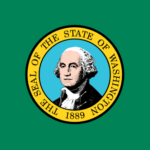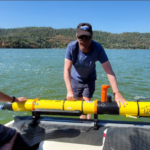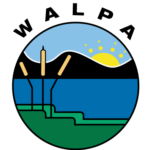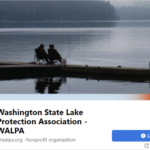Decoding the food web for Omak Lake, the largest saline lake in Washington
by Alexander D Reyes, Ph.D. candidate, Washington State University
Co-authors: Barry C. Moore, Timothy N. Taylor, Bryan Jones.
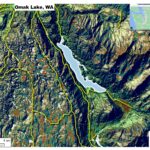 Alkaline lakes are often found in graben and fault basins and in sites of active or recent volcanism where surface water outflows are absent or greatly reduced compared to inlet volumes (Stüekena et al. 2015). Omak Lake is located in Okanogan County in north central Washington, within the western portion of the Reservation of Colville Confederated Tribes (CCT). It is the largest saline lake in the state (Bennet 1962 and WSU 1978), with a lake surface area of 3,820 acres (~1,550 ha). The surface elevation is approximately 935 ft (285 m) above sea level. The maximum lake length is 7.5 miles (12 km), and average width is 0.75 mile (1.2 km). Estimated average lake volume is 30,710,000,000 ft3 (705,000 acre-ft, 869,610,360 m3), average depth is 185 ft (56 m) and maximum depth is ~330 ft (100 m).
Alkaline lakes are often found in graben and fault basins and in sites of active or recent volcanism where surface water outflows are absent or greatly reduced compared to inlet volumes (Stüekena et al. 2015). Omak Lake is located in Okanogan County in north central Washington, within the western portion of the Reservation of Colville Confederated Tribes (CCT). It is the largest saline lake in the state (Bennet 1962 and WSU 1978), with a lake surface area of 3,820 acres (~1,550 ha). The surface elevation is approximately 935 ft (285 m) above sea level. The maximum lake length is 7.5 miles (12 km), and average width is 0.75 mile (1.2 km). Estimated average lake volume is 30,710,000,000 ft3 (705,000 acre-ft, 869,610,360 m3), average depth is 185 ft (56 m) and maximum depth is ~330 ft (100 m).
A new approach to managing Harmful Algae Blooms
WATERLINE SPONSORED CONTENT
by Terry McNabb, AquaTechnex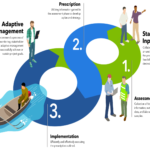
As most lake watchers know, Harmful Algae Blooms (HAB) caused by cyanobacteria are an increasing problem in Washington State. As phosphorus pollution increases in our lakes and reservoirs, cyanobacteria gain a competitive advantage and thrive. During blooms, these species can produce both acute and chronic toxins.
News articles each year talk about dogs dying soon after a visit to a local lake, and there have been cases of livestock and wildlife mortality around affected lakes. In the southeastern United States, a species of cyanobacteria has been directly linked to waterfowl and raptor deaths. This cyanobacterium grows on hydrilla plants that are ingested by coots and other waterfowl and cause brain vacuoles to form. As they lose their motor skills, the birds become easy prey for eagles and other raptors. This fatal disease then moves up the food chain. It’s not a stretch to think similar impacts could affect humans.
Lake advocates! Let your voices be heard!
As the Washington State Legislative session winds down, let your legislators know how you feel about issues that affect lakes. Visit https://www.walpa.org/legislative-initiatives/ to learn about bills that WALPA is watching or supporting and contact your representatives!
High-resolution mapping of a harmful algal bloom
WATERLINE SPONSORED CONTENT
from YSI/Xylem
As we know, Harmful Algal Blooms (HABs) are one of greatest global threats to surface water quality, harming drinking water sources, wildlife habitat, recreational opportunities and waters of special significance to indigenous people. The impacts of HAB’s can range from nuisance taste and odors to production of powerful toxins that can sicken animals and people.
Excessive nutrient loading, especially with nitrogen and phosphorus, can lead to HABs. Adding in warmer water temperatures (as from climate change) and water column stratification boosts cyanobacteria growth.
Western Regional Conference coming soon!
Planning for the Western Regional Conference continues! This conference is targeted towards lakeside residents, lake recreators and everyone else who loves lakes! Keep an eye out for the conference date and agenda soon. In the meantime, look forward to learning and sharing more about some of your favorite lake topics:
- Lakes 101
- Organizing a lake group
- Cyanobacteria and toxic algae
- Aquatic plants
- Experiences of local lake groups
Dear Dr. Waterline:
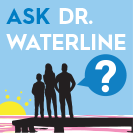 I don’t understand why bacteria in my lake is bad. Isn’t bacteria natural? If it isn’t, how does it get in my lake? And how can I stop it?
I don’t understand why bacteria in my lake is bad. Isn’t bacteria natural? If it isn’t, how does it get in my lake? And how can I stop it?
— Wondering
Follow WALPA on Facebook!
The WALPA communication team continues to post regularly on the WALPA Facebook page and encourages members to follow us. We will post current news about lake management, WALPA content, events, job announcements, and more. Stay in the loop and follow us on Facebook!

